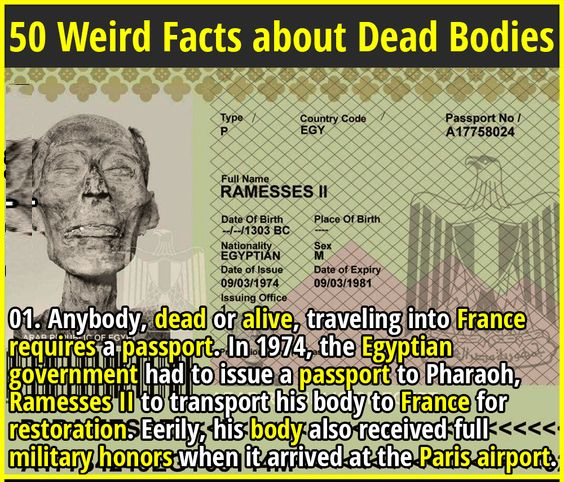Death is a topic often shrouded in mystery and curiosity, and the human body’s journey after death is no exception. While discussing this subject, it’s important to approach it with sensitivity and respect. In this article, we will explore 50 fascinating and unusual facts about what happens to human bodies after death. These facts shed light on the science, customs, and cultural aspects surrounding the end of life.
Decomposition and Changes in the Body:
Decomposition Starts Immediately: Upon death, the process of decomposition begins immediately, as the body’s cells and tissues break down.
Pallor Mortis: The skin becomes pale or bluish soon after death, due to the lack of oxygen circulation.
Rigor Mortis: Stiffening of muscles sets in a few hours after death, making the body rigid.
Livor Mortis: Blood settles in the lower parts of the body, causing distinct discoloration of the skin.
Bloating: Decomposition gases can cause the body to bloat, altering its appearance.
Insect Attraction: Insects, particularly blowflies, are attracted to the body during decomposition, aiding forensic entomology.
Autopsy’s Role: Autopsies can determine the cause of death, providing crucial information in legal and medical investigations.
Embalming: Embalming is a method used to temporarily preserve the body for viewing during funerals and visitations.
Disposal of the Deceased:
Cremation: Cremation is a common method of disposing of the deceased’s remains, reducing the body to ashes.
Body Donation: Some people choose to donate their bodies to science for medical education and research.
Green Burials: Natural or green burials have gained popularity as eco-friendly alternatives to traditional burial methods.
Cryonics: In hopes of future revival, some opt for cryonics, where the body is frozen at ultra-low temperatures.
Corpse Wax: Adipocere, also known as corpse wax, can form when bodies are exposed to moisture, slowing down decomposition.
Decomposition Timeline: The rate of decomposition varies, taking weeks to years depending on the environment and conditions.
Postmortem Muscle Contractions: Spontaneous muscle contractions can give the illusion that the body is moving after death.
Identification and Science:
Dental Records: Dental records are often used for identifying human remains when traditional identification methods are impossible.
Forensic Entomology: Insect activity around a body can help determine the time of death in forensic investigations.
Longevity of Bones: Human bones can last for centuries, providing invaluable insights into the past.
Mummies: Preserved using various methods, mummies offer glimpses into ancient civilizations and their burial customs.
Mass Graves: Mass graves are used during times of disaster or war to bury large numbers of people.
Organ Donation: Some choose to donate their organs to save lives even after their death.
Unique Customs and Practices:
Sky Burials: In certain cultures, like Tibetan Buddhism, sky burials involve exposing the body to vultures.
Water Burials: Some opt for water burials at sea, returning the body to the water.
Body Farms: Research facilities, known as “body farms,” study decomposition under various conditions to aid forensic science.
Postmortem Odor: The unmistakable smell of decomposition can be challenging to mask.
Funeral Industry: The funeral industry is a multi-billion-dollar business, providing a wide range of services.
Rare Phenomena and Cultural Beliefs:
Spontaneous Combustion: In extremely rare cases, some believe in spontaneous human combustion, where bodies catch fire without an external source.
Coffin Birth: “Coffin birth” is a phenomenon where gases push out a fetus from a pregnant woman’s body after her death.
Alkaline Hydrolysis: This eco-friendly alternative to cremation uses a water-based process to break down the body.
Cannibalism: In the past, some societies practiced endocannibalism, consuming deceased relatives for various reasons.
Death Masks: Death masks were created to capture the likeness of the deceased person’s face.
Postmortem Photography: In the 19th century, it was common to take photographs of the deceased as a way of preserving their memory.
Cultural Beliefs and Traditions:
Skulls and Bones: Some ancient cultures used human skulls and bones in rituals and decorations.
Zombie Folklore: The idea of the “zombie” originates from Haitian folklore, where reanimated corpses are believed to exist.
Pre-planned Funerals: Some individuals pre-plan their funerals and make arrangements for their own death.
Ongoing Smell: The smell of decomposition can linger in the environment even after the body has decomposed.
The “27 Club”: A superstition surrounds the “27 Club,” suggesting that many famous musicians died at the age of 27.
Funeral Services: Funerals and memorial services serve as a way for loved ones to say their final goodbyes and find closure.
Conclusion:
The journey of the human body after death is an intriguing, diverse, and sometimes unsettling subject that continues to captivate our curiosity. While some facts are unusual or even unsettling, they all serve to deepen our understanding of this inevitable part of life. It is essential to approach these facts with respect, empathy, and cultural sensitivity, acknowledging the significance of the end of life in various societies and beliefs.
